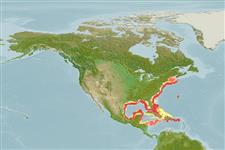Elasmobranchii (Haie und Rochen) (sharks and rays) >
Carcharhiniformes (Ground sharks) >
Scyliorhinidae (Cat sharks) > Scyliorhininae
Etymology: Scyliorhinus: skylion, Greek for dogfish or small shark; rhinus, from rhine (Gr.), rasp, alluding to a shark’s jagged, rasp-like skin. (See ETYFish); retifer: rete, diminutive of reticulum (L.), net; -fer, from fero (L.), to have or bear, referring to its mesh- or chain-like pattern. (See ETYFish).
More on author: Garman.
Environment: milieu / climate zone / depth range / distribution range
Ökologie
seewasser demersal; tiefenbereich 36 - 750 m (Ref. 26938). Subtropical; 45°N - 15°N, 99°W - 64°W (Ref. 55294)
Western Atlantic: southern New England to Florida in the USA and northern Gulf of Mexico to Nicaragua. Atlantic coast from Cape Cod to Florida, and west Caribbean from Yucatan to Nicaragua (Ref. 26938).
Size / Gewicht / Alter
Maturity: Lm ? range ? - ? cm
Max length : 48.0 cm TL Männchen/unbestimmt; (Ref. 26938); 47.0 cm TL (female)
Body small and slender; boldly marked body with a pattern of distinct black lines on a pale brownish background. Origin of the first dorsal fin behind free rear tip of pelvic fin (Ref. 26938).
Found on the outer continental shelf and upper slope on rough, rocky bottom. Water temperature: 8.5-11.3°C. Food habits unknown. Oviparous. Not utilized at present. Found in waters 75-550 m deep (Ref. 26938). Lives at depths off 36-230m in the northern portion of its range, and in waters deeper than 460m in its southern range (Ref. 55294). Maximum depth reported taken from Ref. 55584.
Life cycle and mating behavior
Geschlechtsreife | Fortpflanzung | Ablaichen | Eier | Fecundity | Larven
Oviparous, paired eggs are laid. Embryos feed solely on yolk (Ref. 50449). During courtship and prior to copulation, the male bites and wraps female pectoral fin body, tail and gills (Ref. 49562, 51128).
Compagno, L.J.V., 1984. FAO Species Catalogue. Vol. 4. Sharks of the world. An annotated and illustrated catalogue of shark species known to date. Part 2 - Carcharhiniformes. FAO Fish. Synop. 125(4/2):251-655. Rome: FAO. (Ref. 244)
IUCN Rote Liste Status (Ref. 130435)
Bedrohung für Menschen
Harmless
Nutzung durch Menschen
Fischereien: nicht kommerziell
Mehr Information
ReferenzenAquakulturAquakultur ProfilZuchtlinienGenetikElectrophoresesVererbbarkeitKrankheitenVerarbeitungNutrientsMass conversion
PartnerBilderStamps, Coins Misc.LauteCiguateraGeschwindigkeitSchwimmstilKiemenoberflächeOtolithsGehirngrößeSehfähigkeit
Tools
Zusatzinformationen
Download XML
Internet Quellen
Estimates based on models
Preferred temperature (Ref.
123201): 11.4 - 22.7, mean 16.8 °C (based on 93 cells).
Phylogenetic diversity index (Ref.
82804): PD
50 = 0.5000 [Uniqueness, from 0.5 = low to 2.0 = high].
Bayesian length-weight: a=0.00219 (0.00139 - 0.00345), b=3.17 (3.04 - 3.30), in cm total length, based on LWR estimates for this species & (Sub)family-body (Ref.
93245).
Trophic level (Ref.
69278): 4.4 ±0.3 se; based on diet studies.
Widerstandsfähigkeit (Ref.
120179): niedrig, Verdopplung der Population dauert 4,5 - 14 Jahre. (Fec assumed to be <100).
Fishing Vulnerability (Ref.
59153): Moderate vulnerability (38 of 100).
